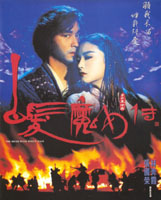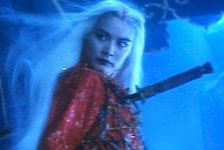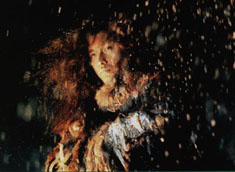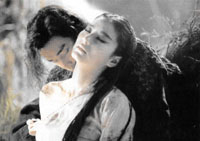|
“Mad Blood Stirring” (p. 4)
by Eleanor M. Farrell
|
 |
Ronnie Yu’s 1993 “FantAsia” film, The Bride with White Hair, appears on most critical and popular lists of the best of Hong Kong cinema from the period of the colony’s most fertile celluloid output, and won multiple awards on its release. Based on a popular 1950s novel by Liang Yu-shing, the film transcends its roots in wuxia swordplay movies by incorporating a panoply of pan-Asian aesthetic elements (especially costume and set design), stressing romantic drama and complex characterization, and emphasizing its Shakespearean theme, all while keeping true to the Ming dynasty code of the Jiang-hu — the martial underworld of Chinese kung fu. The alternate Cantonese title, Jiang-hu: Between Love and Glory, better states the theme: two young lovers from opposing clans face the consequences of trying to balance love with martial honor. The story is told within a frame, by the young hero who has spent ten years on an isolated mountain top, waiting for a flower to bloom.
|
Cho Yi-hang (played by Leslie Cheung), a consumate Wu Tang warrior groomed as an unwilling successor to the allied Eight Clans, is striving to escape the conflict his position forces on him when he first sees a beautiful woman (portrayed by Brigitte Lin) assisting a fleeing villager to give birth, in the midst of an attack by soldiers. Unfortunately, Lien the Wolf Girl — so-called because she was raised by wolves before being taken in and trained as an assassin — is allied with the rival Supreme (or Blood) Cult. This doesn’t stop the two from falling instantly in love, vowing eternal trust, and deciding to leave the martial underworld, which is easier said than done. Lien announces to her cult leader that she is leaving and is forced to undergo a grueling physical trial. Cho, meanwhile, is confronted by his own clan members and accused of sleeping with the enemy. When he returns to the Wu Tang palace to face his teacher, everyone in the building is dead, and Lien blamed for the slaughter. Under the pressure from the surviving clan members, Cho turns against Lien, whose hair turns white in anguish, and she retaliates by killing just about everybody else left alive. The true villain, the Supreme Cult leader (actually a male-female Siamese twin with supernatural destructive powers), returns to finish the job and is finally vanquished by Cho and Lien. Although Cho tries to make up for his earlier distrust, Lien leaves him, and he goes away himself to Mount Shin Fung, where a marvellous flower that blooms once every twenty years can help restore her beauty and love.
|
 |
Director Ronnie Yu refers (2) to his film as a “Romeo and Juliet” story; the lovers’ struggle against fate and their heroic duty inspired him more than the familiar trappings of most martial arts adventures. (Liang’s novel had several previous movie incarnations, including the unintentionally silly 1980 White Haired Devil Lady.) Although the film is in fact based on another written source, the main themes of Shakespeare’s play shine through: feuding clans, each full of pride and arrogance, and each culpable for transgressions against the common people and each other; two lovers rejecting the bonds of conflict and hoping to build a life for themselves outside the world to which they belong; fate and the demands of honor creating an impossible barrier.
|
 |
But the traditions of Chinese culture, and the credo of the wuxia pian, help shape this story into a uniquely Asian fable. One particularly intriguing element is the importance of one’s name. In Shakespeare’s play, Juliet rails against the barrier that Romeo’s surname presents, and muses about both of them denying their heritage so that they can be together. In Yu’s film, the heroine has no biological family (although her surname “Lien” is tattooed on her shoulder); it is her lover Cho Yi-hang who, stating that “everyone should have a name,” calls her Ni-chang. When Lien rejects the Supreme Cult, the leader demands to know what her lover has given her, and she replies, “A name.” And when Lien rejects Cho after his mistaken betrayal, he calls her name, “Ni-chang,” but she answers, “She is dead.” It is honor and trust, more than love, that shape the destinies of Cho Yi-hang and Lien Ni-chang: no matter which course they choose, honor is forfeit and disaster inevitable. Although there is no double suicide here — in the end, everybody dies except the two lovers — each of them does in fact choose death. Lien rejects the name her lover has given her, and Cho rejects his heritage to spend the next ten years waiting for a chance to redeem his error in judgment. In the film’s sequel (Bride with White Hair 2), set ten years later, Lien is still wreaking havoc on the next generation of the Wu Tang clan and Cho is still waiting on his mountain. When they finally do meet again, it is to their own mutual destruction, although tempered with forgiveness. This is the only reconciliation the story provides.
|
 |
In summary, the main theme of Romeo and Juliet — love vs. duty/family/honor — is a universal conflict which makes the play relevant to practically any culture. The specific trappings of films produced in different countries show adaptations that reflect individual cultural elements of each society. The particulars of the feud (or lack thereof), the role of fate, importance of family or clan, and the outcome for the lovers all vary according to the traditions of the society creating the story.
|
|
|
|
| (2) Director’s audio commentary, The Bride with White Hair DVD (Tai Seng, 1993). Two years later, Ronnie Yu and Leslie Cheung teamed up for another film, The Phantom Lover, which incorporates elements from Romeo and Juliet, The Phantom of the Opera, and a 1937 Chinese horror film called Midnight Charm. The 1920s Beijing romance between innovative stage actor/producer Song Danping and a local beauty is violently opposed by her ambitious family, resulting in madness (hers), disfigurement (his), and destruction (the theater’s). Ten years later, the arrival of a new acting troupe, who decide to restage Song’s original musical production of Romeo and Juliet, stirs up the ashes of the earlier tragedy. Cheung’s impressive film resumé shows the actor’s particular affinity to these stories: in addition to his two productions with Yu, he also starred with Anita Mui in Stanley Kwan’s 1987 art-house hit Rouge. Also set partly in the ’30s, this film centers around a tragic affair between a courtesan and the son of an affluent merchant family. When their marriage is opposed, the two form a suicide pact and overdose on opium. Fifty years later, the woman’s ghost returns to Hong Kong to find the lover who failed to join her in the underworld. |
|
|
|
|
|
| Dedication: This paper is dedicated to the memory of Leslie Cheung, whose immeasurable contributions to world cinema include my own fond obsession with Asian film. |



